
A listed building, or listed structure, is one that has been placed on one of the four statutory lists maintained by Historic England in England, Historic Environment Scotland in Scotland, Cadw in Wales and the Northern Ireland Environment Agency in Northern Ireland.

Henry Dundas, 1st Viscount Melville, PC, FRSE, styled as Lord Melville from 1802, was a Scottish advocate and independent Whig politician. He was the trusted lieutenant of British prime minister William Pitt, and the most powerful politician in Scotland in the latter decades of the 18th century.

Robert Dundas, 2nd Viscount Melville was a British statesman, the son of Henry Dundas, the 1st Viscount. Dundas was the Member of Parliament for Hastings in 1794, Rye in 1796 and Midlothian in 1801. He was also Keeper of the Signet for Scotland from 1800. He was appointed a Privy Counsellor in 1807, a Fellow of the Royal Society in 1817, a Knight of the Thistle in 1821, and was Chancellor of the University of St Andrews from 1814. Melville filled various political offices and was First Lord of the Admiralty from 1812 to 1827, and from 1828 to 1830; his eldest son inherited his title.
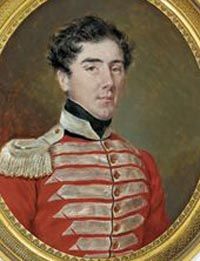
General Henry Dundas, 3rd Viscount Melville GCB was a senior British Army officer and peer.

Viscount Melville, of Melville in the County of Edinburgh, is a title in the Peerage of the United Kingdom.

Stewart's Melville College (SMC) is an independent day and boarding school in Edinburgh, Scotland. Classes are all boys in the 1st to 5th years and co-educational in Sixth (final) year. It has a roll of about 750 pupils.
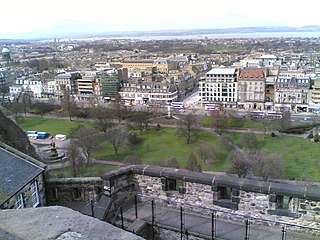
The New Town is a central area of Edinburgh, the capital of Scotland. It was built in stages between 1767 and around 1850, and retains much of its original neo-classical and Georgian period architecture. Its best known street is Princes Street, facing Edinburgh Castle and the Old Town across the geological depression of the former Nor Loch. Together with the Old Town, the New Town was designated a UNESCO World Heritage Site in 1995. The area is also famed for the New Town Gardens, a heritage designation since March 2001.

Wellington's Column, or the Waterloo Memorial, is a monument to the Duke of Wellington standing on the corner of William Brown Street and Lime Street, Liverpool, Merseyside, England. It is recorded in the National Heritage List for England as a designated Grade II* listed building.
The Historic Cities Programme (HCP) of the Aga Khan Trust for Culture (AKTC) promotes the conservation and re-use of buildings and public spaces in historic cities of the Muslim world. HCP undertakes the restoration and rehabilitation of historic structures and public spaces in ways that can spur social, economic and cultural development. Individual projects go beyond technical restoration to address the questions of the social and environmental context, adaptive reuse, institutional sustainability and training. In several countries, local Aga Khan Cultural Service companies have been formed to implement projects under the supervision of the HCSP headquarters in Geneva.

St Andrew Square is a garden square in Edinburgh, Scotland located at the east end of George Street. The gardens, part of the collection of New Town Gardens, are owned by a number of private owners, managed by Essential Edinburgh and opened to the public in 2008. The construction of St Andrew Square began in 1772, as the first part of the New Town, designed by James Craig. Within six years of its completion St Andrew Square became one of the most desirable and most fashionable residential areas in the city. As the 19th century came to a close, St Andrew Square evolved into the commercial centre of the city.

This article details the history and status of Heritage conservation in Hong Kong, as well as the role of various stakeholders.
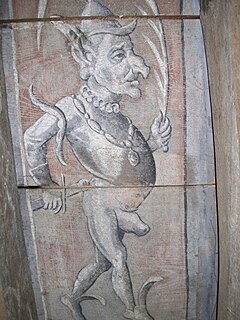
Scottish renaissance painted ceilings are decorated ceilings in Scottish houses and castles built between 1540 and 1640. This is a distinctive national style, though there is common ground with similar work elsewhere, especially in France, Spain and Scandinavia. An example in England, at Wickham, Hampshire, was recorded in 1974. There are records of over 100 examples, and a much smaller number of painted ceilings survive in-situ today. Some salvaged painted beams and boards are stored by Historic Environment Scotland. The paintings at Crathes Castle, dating from 1597 are probably the best known.
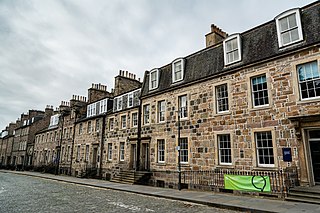
George Square is a city square in Edinburgh, Scotland. It is in the south of the city centre, adjacent to the Meadows. It was laid out in 1766 outside the overcrowded Old Town, and was a popular residential area for Edinburgh's better-off citizens. In the 1960s, much of the square was redeveloped by the University of Edinburgh, although the Cockburn Association and the Georgian Group of Edinburgh protested. Most but not all buildings on the square now belong to the university. Principal buildings include the Gordon Aikman Lecture Theatre, Edinburgh University Library, 40 George Square and Appleton Tower.

Parliament Square, Edinburgh, is located off the High Street, part of the Royal Mile. The square is not a formal square, but consists of two sections surrounding St Giles Kirk on three sides: an L-shaped area to the east and south and another area on the west side of the church called West Parliament Square. The Edinburgh Mercat Cross is located on the east side of the square while an equestrian statue of Charles II of Scotland stands in front of the entrance to the Supreme Courts of Scotland adjoining Parliament House, on the west side. The Queensberry Memorial to the 5th Duke of Buccleuch, stands in West Parliament Square.
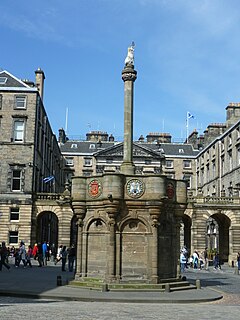
The Mercat Cross of Edinburgh is a market cross, the structure that marks the market square of the market town of Edinburgh. It stands in Parliament Square next to St Giles' Cathedral, facing the High Street in the Old Town of Edinburgh.
Essential Edinburgh manage the Edinburgh New Town city centre Business Improvement District (BID). The area covered stretches from Charlotte Square to the new St. James Centre. Their offices are at 139 George Street.

Dundas Street is a major historic arterial road in Ontario, Canada. The road connects the city of Toronto with its western suburbs and several cities in southwestern Ontario. Three provincial highways—2, 5, and 99—followed long sections of its course, although these highway segments have since been downloaded to the municipalities they passed through. Originally intended as a military route to connect the shipping port of York to the envisioned future capital of London, Ontario, the street today connects Toronto landmarks such as Yonge–Dundas Square and the city's principal Chinatown to rural villages and the regional centres of Hamilton and London.

The Melville Monument is a large column in St Andrew Square, Edinburgh, Scotland, constructed between 1821 and 1827 as a memorial to Henry Dundas, 1st Viscount Melville.

Elizabeth Rannie, also known as Elizabeth Rennie, (1750–1847) was a Scottish noblewoman who was married to Henry Dundas, 1st Viscount Melville, and was mother to Robert Dundas, 2nd Viscount Melville.

















